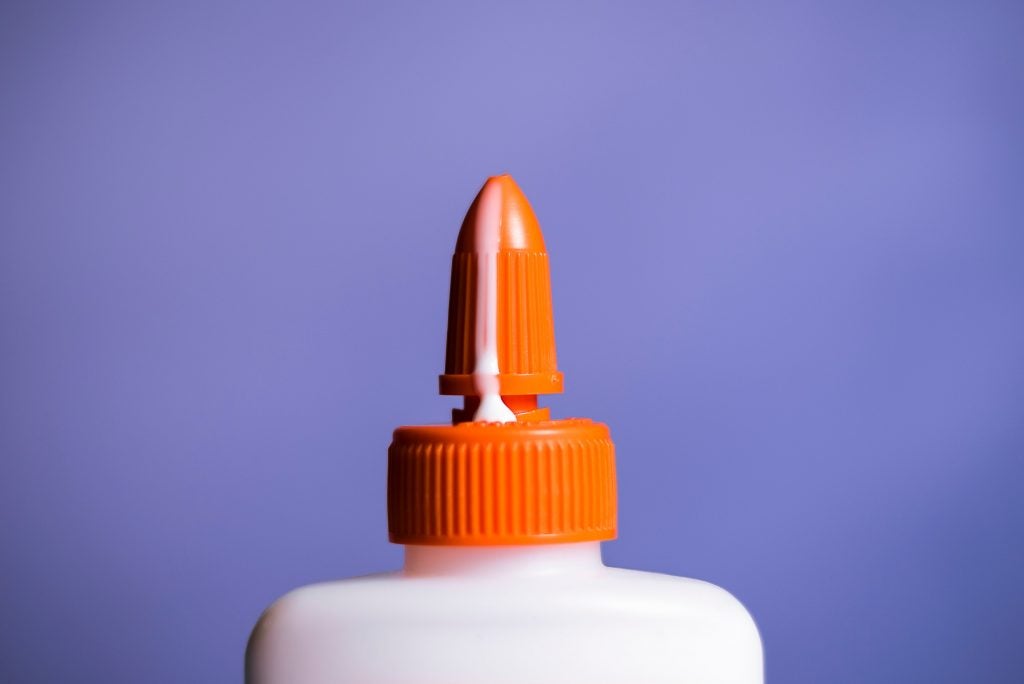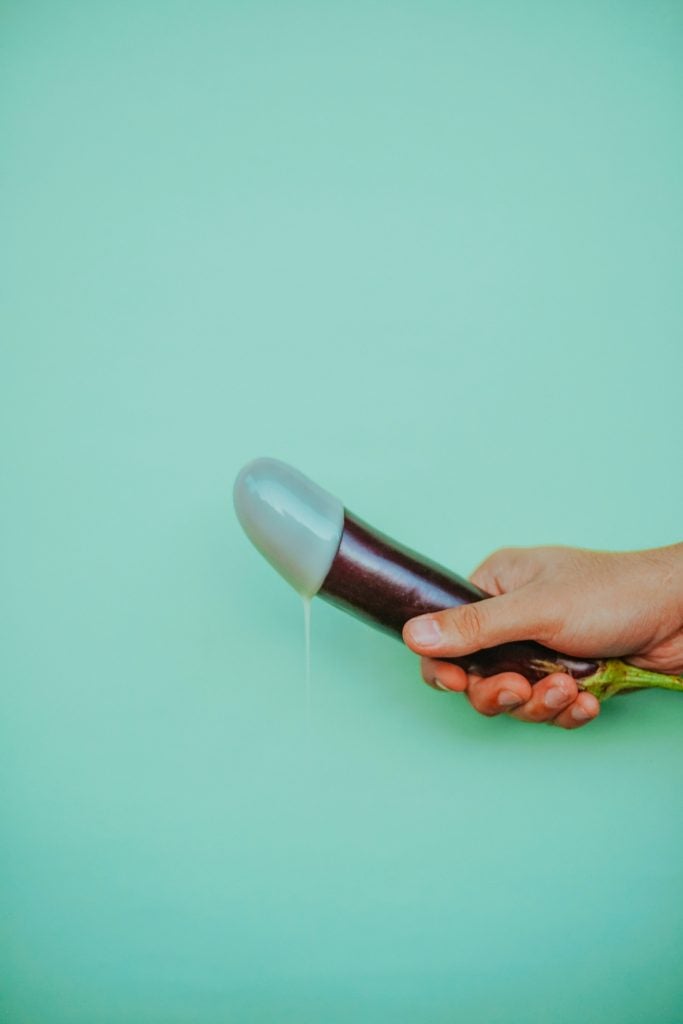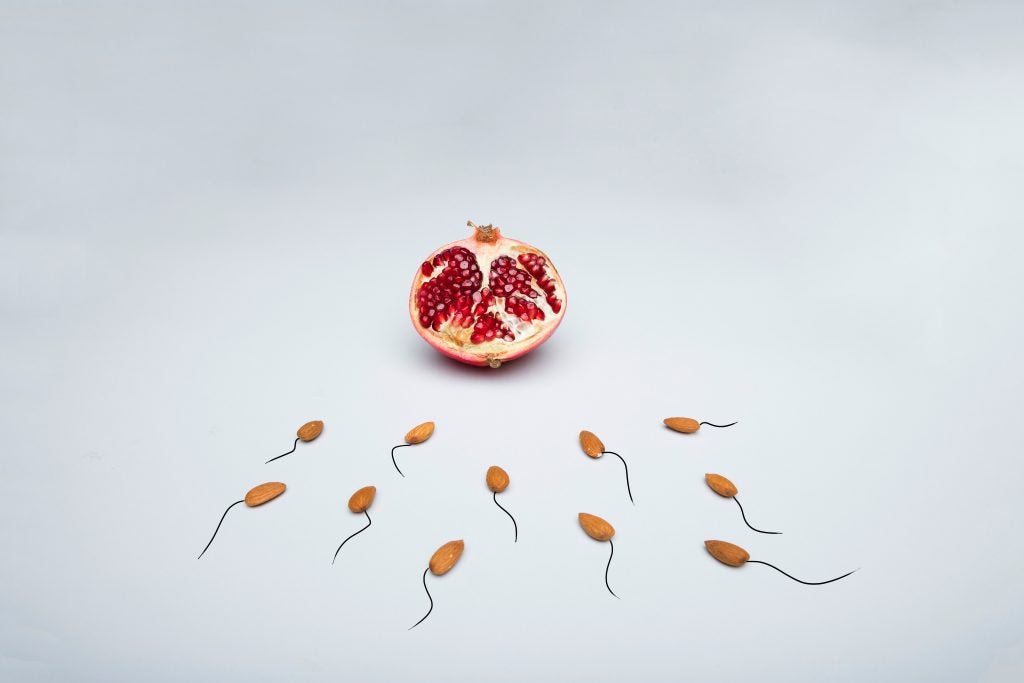Table of Contents
What is Semen?

Semen (meaning seed in Latin), male ejaculate, or “cum,” is a combination of seminal fluid and mature sperm (spermatozoa), which is ejaculated through the urethra during the male orgasm. Semen is the medium through which a male’s sperm is delivered to a female’s egg cell, or ovum, during procreative sex. Boys start producing both semen and mature sperm during puberty.
Appearance and Consistency
Semen is a semi-transparent fluid that may be white, gray, or slightly yellow in color.*
Semen immediately thickens upon leaving the penis into a sticky, viscoelastic/gelatinous material and slowly liquefies over the course of 5 to 30 minutes to become a watery substance. Both the coagulation and liquefaction of semen are the result of chemical reactions between the different components of the fluid, for which the seminal vesicles and prostate are chiefly responsible (in respective order).1
The density and viscosity of semen when liquefied may be compared to that of refrigerated milk of varying fat content or room temperature half-and-half.1,2,3 Immediately after ejaculation, the viscosity of semen may be approximately 100 times higher making it comparable to SAE 40 motor oil at room temperature.1,4
The pH of semen is commonly measured between 7.2 and 8.5 (slightly basic).1 For comparison, this pH range overlaps greatly with that of seawater (7.5 – 8.4). Semen also has a high buffering capacity; it is capable of rendering the environment of the vagina (which is normally slightly acidic) neutral shortly after ejaculation.1,5
For more about the properties of semen, specifically taste and how to change it, see swallowing your partner’s ejaculate.
*Note that a pink hue may indicate the presence of blood in a man’s semen – a condition known as hematospermia. While often not a serious medical problem, it may merit a doctor’s attention for men over 40 or if the problem persists.6
What is in Semen?

Semen is mostly water, but it also contains amino acids and protein, sugars, minerals, and in fertile men sperm cells!1
The combination of fluids that comprise the seminal fluid are produced by a series of male sex glands: namely the prostate, seminal vesicle, and bulbourethral (Cowper’s) glands. Sperm are produced in the testes, stored in the epididymis, and forced into the urethra through the vas deferens during ejaculation. For an overview of the male reproductive system, see our full article.
These fluids are incompletely mixed when ejaculated from the penis, and the first fluids to leave the penis during an ejaculation are typically dominated by sperm and prostatic fluid while later fluids are mostly from the seminal vesicle.7
While a typical ejaculate from fertile men may contain up to 500 million sperm, the testes contribute 5% or less of the volume of semen. Men who have undergone a vasectomy or otherwise sterile men thus have no noticeable differences in the consistency, look, feel, or taste of their semen. Approximately 30% of the volume of seminal fluid comes from the prostate, which produces an alkaline (basic) fluid to neutralize the low (acidic) pH of the vagina. Approximately 70% of the ejaculate comes from the seminal vesicles, which provides fructose (a sugar also found naturally in fruits) and other nutrients for the sperm cells.8
| Organ | Ingredients contributed | Percentage by Volume |
| Seminal Vesicle | Amino acids, proteins, sugars, vitamin C | 46-80% |
| Prostate | Enzymes, zinc | 13-33% |
| Testes | Sperm | 5% |
| Bulbourethral and Urethral Glands | Alkaline fluid which also serves as pre-ejaculate | 2-5% |
For reference, see 1,8
What Happens during Ejaculation?

During a male’s orgasm, two sphincter muscles operate to block off the bladder from the urethra while opening the urethra to the passage of semen. Smooth muscle cells in the walls of the epididymis and vas deferens push sperm through the vas deferens into the urethra, while the prostate, seminal vesicle, and bulbourethral glands also release fluids into the urethra. The resulting mixture of semen is then expelled through the length of the penis and out the tip by the rhythmic contractions of the bulbospongiosus muscle.
When the sphincter muscles do not contract and relax in the correct manner, retrograde ejaculation may occur, whereby semen may enter the male’s bladder. Men who do not consistently release ejaculatory fluid during orgasm may be suffering from retrograde ejaculation and should see a doctor.9
Male ejaculation may occur during partnered sexual activity, masturbation, or even during sleep. Because it is mediated by nerves low in the spinal column, ejaculation may occur before a man wants it to and may still be possible for men with certain types of spinal cord injuries.10
How Much is Ejaculated?
The volume of semen that is expelled during ejaculation can vary widely between men and between individual ejaculates. A 1975 study of 1,300 fertile men aged 23 to 64 found that ejaculates varied between 0.1 and 11 ml, with one standard deviation (~68%) of ejaculates falling between 1.8 and 4.6 ml. For reference, that is the volume of two to seven Skittles (about 1.5 to 5 ml).11 Generally, the volume of ejaculate increases with the time since last ejaculation and with hydration.
Pre-Ejaculate
The bulbourethral (also known as Cowper’s) glands secrete fluid not only during ejaculation, but also during sexual arousal. The fluid released during arousal is known as pre-ejaculate, preseminal fluid, or “pre-cum”, and may (but not always) be seen as a few drops of clear fluid emitted from the tip of the penis. Pre-ejaculate serves to neutralize the acidity of the man’s urethra, as a lubricant, and as a seminal coagulant. Residual sperm may be present in a man’s pre-ejaculate if he has not urinated since his last ejaculation. For this reason, the “pull-out” or withdrawal method is not an effective method of contraception, since a woman may be exposed to sperm without ejaculation ever occurring.
Cultural Significance
Throughout history, various traditions have described semen as having magical properties, capable of conferring the essence of manhood and masculinity. Several Greek heroes and gods were supposed to have been born when the semen of a god hit the earth or the sea. Among the Etoro people of Papua New Guinea, younger males between the ages of approximately 10 and 20 perform fellatio on grown men and swallow their semen daily in order to plant within themselves the seed of manhood. Similar practices are noted among neighboring tribes.12
Health Benefits

Semen is commonly believed to have a number of health benefits, obtained by swallowing it, applying it to the skin, or allowing it to be absorbed through the vaginal walls.
In our full article on swallowing semen, we conclude that there is no compelling evidence that swallowing semen provides any dietary benefits.
While some people advocate applying semen to the skin, the justifications provided for this practice are often questionable and may result in more harm than good for individuals with seminal plasma hypersensitivity (an allergy, albeit rare, to the proteins found in semen).
Some studies have suggested that semen acts as an anti-depressant or reduces the risk of breast cancer, yet such studies have relied on survey responses regarding contraceptive methods to infer semen exposure and have limited their analysis to heterosexual partners.13,14,15 Because correlation does not imply causation, it should be cautioned against to attribute the findings of these studies to the properties of semen.
A more substantiated finding is that exposing a pregnant female to the semen of the child’s father may benefit the success of the pregnancy by conditioning the mother’s immune system to better tolerate the conceptus.16
Any other health benefits commonly assigned to semen are likely false, psychological effects, or are better understood through the health benefits of sex in general.
Other Uses
Semen fluoresces under ultraviolet light. For this reason, because it was readily available, and because it is undetectable by exposure to iodine vapor, the British Secret Intelligence Service used semen as invisible ink During World War I. Despite these benefits however, if not fresh, the “ink” developed a pungent smell.17
References
- Owen, Derek H., and David F. Katz. “A Review of the Physical and Chemical Properties of Human Semen and the Formulation of a Semen Simulant”. Journal of Andrology 26.4 (2005): 459-469. Web. 6 Feb. 2015.
- Bakshi, A.S., and D.E. Smith. “Effect of Fat Content and Temperature on Viscosity in Relation to Pumping Requirements of Fluid Milk Products”. Journal of Dairy Science 67.6 (1984): 1157-1160. Web.
- Matson, Phillip L. et al. “The Density of Human Semen and the Validation of Weight as an Indicator of Volume: A Multicentre Study”. Reproductive Biology 10.2 (2010): 141-153. Web.
- OEC Fluid Handling. “Viscosity Information”. N.p., 2015. Web. 26 Feb. 2015.
- Webmd.com. “Vaginal Wet Mount”. N.p., 2015. Web. 26 Feb. 2015.
- Stefanovic, Ksenija B.; Gregg, Peter C.; Soung, Michael. “Evaluation and Treatment of Hematospermia”. American Academy of Family Physicians. N.p., 2015. Web. 26 Feb. 2015.
- TAUBER, P. F. et al. ‘COMPONENTS OF HUMAN SPLIT EJACULATES’. Reproduction 43.2 (1975): 249-267. Web.
- Dawson, Chris. “Semen and Sperm Quality”. Netdoctor.co.uk. 2015. Web. 6 Feb. 2015.
- SexInfoOnline. “Retrograde Ejaculation”. N.p., 2015. Web. 26 Feb. 2015.
- Ducharme, Stanley. “Sexuality and Spinal Cord Injury”. Stanleyducharme.com. N.p., 2015. Web. 26 Feb. 2015.
- Naghma-E-Rehan, Aquiles J. Sobrero, and John W. Fertig. “The Semen of Fertile Men: Statistical Analysis of 1300 Men”. Obstetrical & Gynecological Survey 31.1 (1976): 52-55. Web. 6 Feb. 2015.
- Herdt, Gilbert H. Ritualized Homosexuality In Melanesia. Berkeley: University of California Press, 1984. Web. Accessed 25 Feb. 2015
- Gallup Jr., Gordon G., Rebecca L. Burch, and Steven M. Platek. “Does Semen have Antidepressant Properties?” Archives of Sexual Behavior 31.3 (2002): 289-293. Web. 6 Feb. 2015.
- Gjorgov, Arne N. “Barrier Contraceptive Practice and Male Infertility as Related Factors to Breast Cancer in Married Women”. Medical Hypotheses 4.2 (1978): 79-88. Web. 7 Feb. 2015.
- Lê, Monique G., Annie Bachelot, and Catherine Hill. “Characteristics of Reproductive Life and Risk of Breast Cancer in a Case-Control Study of Young Nulliparous Women”. Journal of Clinical Epidemiology 42.12 (1989): 1227-1233. Web. 7 Feb. 2015.
- Tremellen, K. P. “The Effect Of Intercourse On Pregnancy Rates During Assisted Human Reproduction”. Human Reproduction 15.12 (2000): 2653-2658. Web. 6 Feb. 2015.
- Telegraph.co.uk. ‘MI6 ‘Used Bodily Fluids As Invisible Ink’ – Telegraph’. N.p., 2010. Web. 26 Feb. 2015.
Last Updated: 10 March 2015.
